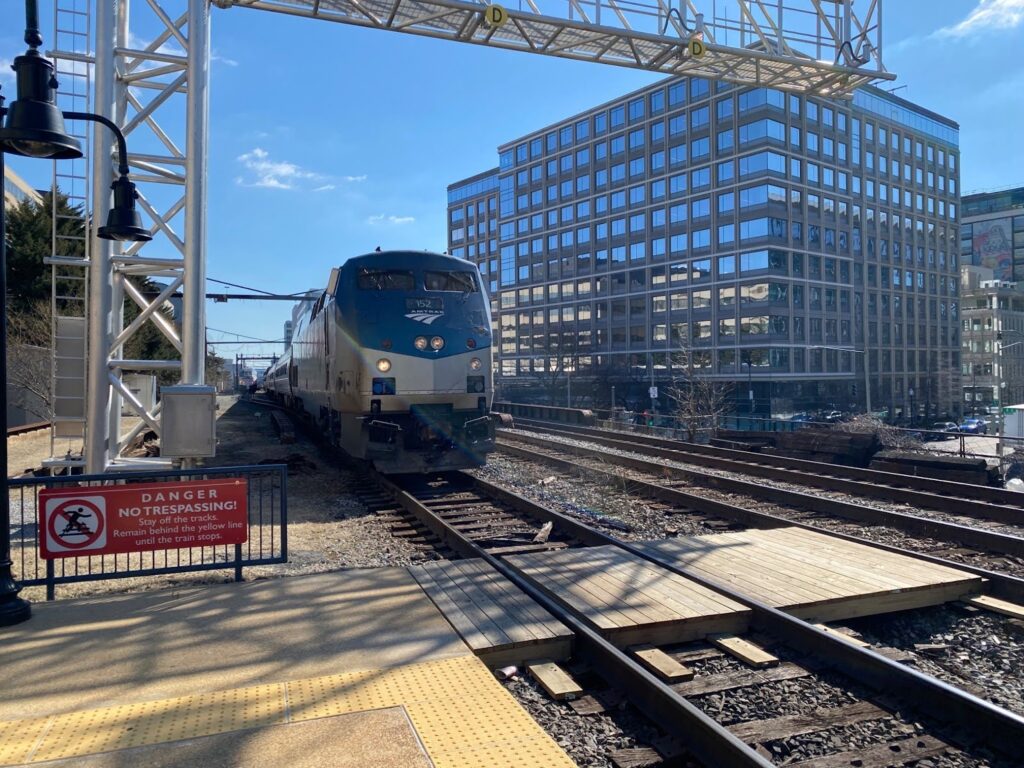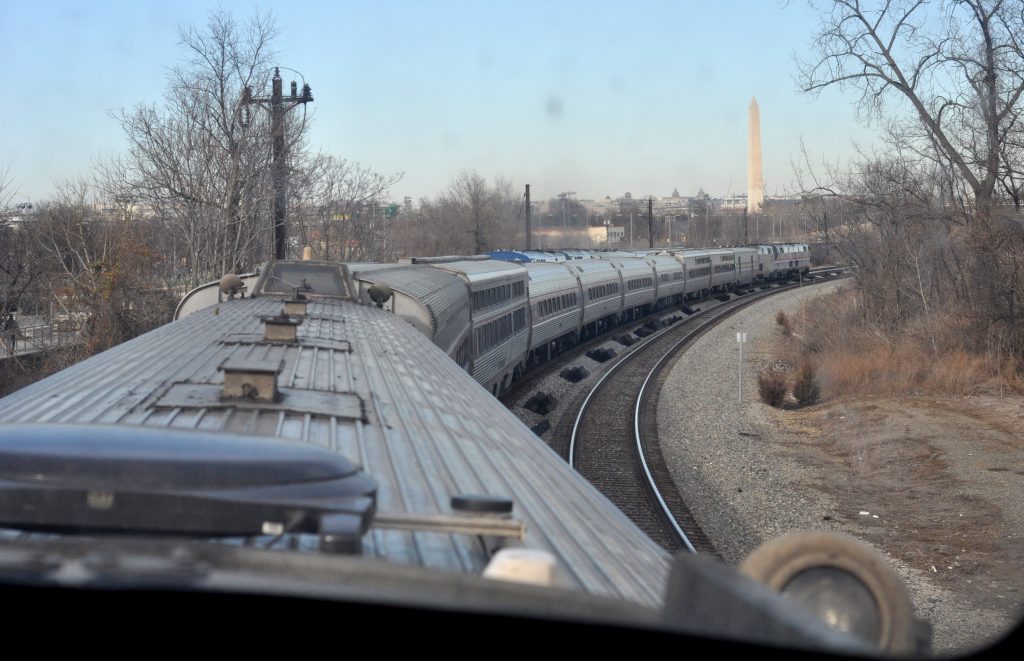
House builds on the FAST Act’s change to provide better and more balanced passenger rail service

Expanding and improving our nation’s passenger rail network to bring better, more reliable passenger rail service to more people is one of the best ways to improve access for millions of Americans in big urban areas and small rural ones alike. The House transportation bill takes some important steps to balance passenger rail with the rest of our transportation investments. Here are the details.

This is the first of a series of deeper dives into specific areas of the House’s transportation reauthorization proposal. Stay tuned for longer looks at repair (and how it can be improved), climate, access, and others. Read our statement on the bill, how it stacks up to our core three principles, and a quick look at nine other things—good and bad—to know.
Within the reauthorization proposal released by the House Transportation and Infrastructure Committee last week is the Transforming Rail by Accelerating Investment Nationwide Act (TRAIN Act), which lays out ambitious investment priorities and important reforms specifically for the rail component of our national surface transportation reauthorization. The TRAIN Act authorizes an increase in passenger rail funding to five times current levels, for a total of $60 billion total over the next five years. It establishes new programs to help fund capital improvements for existing trains, while making existing programs more effective and usable. In contrast to Congress’s recent attempts to peel off the Northeast Corridor and cancel vital long-distance routes, it re-establishes the centrality of a complete national network of short- and long-distance rail service, including state-supported routes. And it gives Amtrak the legal tools it needs to address bad faith interference from freight carriers.
Capital investment
Passenger rail services often require sizable capital improvements to track, stations, or rolling stock upon startup or on an ongoing basis to keep the service viable. Historically, these hefty expenses have come from Amtrak’s annual appropriation and from states. More recently, beginning with the 2009 Recovery Act, a growing share of passenger rail capital projects have been funded by competitive grant programs administered by the USDOT.
The TRAIN Act authorizes $5.2 billion annually for rail capital improvements which will allow us to make our national passenger train network more reliable, while providing better service and improving the state of good repair across the network. After several years of legislators making attempts to peel off the Northeast Corridor and neglect the National Network, this bill reinforces the balance between them, while also including commuter rail in the capital grant program for the first time. Plus, with an 80 percent federal share for capital grants and a 90 percent share in the new PRIME grant program, local matching dollars will activate more federal investment per dollar than the existing 50-50 split, making rail projects more competitive for local funding when compared to highways that have 90 percent of their costs covered.
Federal loan programs for rail will also become more effective and user friendly by providing funding to offset risk premiums that borrowers must currently pay the government as insurance against possible default.
Operating support
Operating support is key for many new or expanded services. It may not be as flashy as a new station or high speed track, but it helps make tickets affordable and expand the reach of high quality passenger rail across the country.
The bill authorizes the Restoration and Enhancement grant program (REG) program at $20 million annually, a competitive grant program that provides a share of operating support for new or expanded passenger train services. The REG program provides a declining share of operating support to help new and expanded services get established and build a base of riders before transitioning completely to local funds for operating support. As an example, this program is helping the Southern Rail Commission get the new Gulf Coast service restored and established. The grants will enable the three-state commission to offset 80 percent of operating support in the first year of operations with federal funds. In the second and third years, federal funds will cover 60 and 40 percent of operating support respectively. State and local funds will make up the balance during the three-year period.
Shifting trips in a corridor or a city from highways or airports to passenger rail helps reduce emissions, mitigate climate change, and improve air quality. In another important set of changes, funds from the Congestion Mitigation and Air Quality program (CMAQ) could be used to pay for operating support on transportation networks that improve air quality, including state-supported Amtrak routes. Currently, CMAQ funding can’t be used for passenger rail operating support, and its use for transit is mainly for capital projects and procurement, and limited fare reductions when local air quality is worst.
Amtrak
Amtrak, America’s primary passenger rail operator, was established by Congress to take over passenger operations from the private railroads. Amtrak has received an annual appropriation from Congress every year of its existence for capital and operating expenses, though the adequacy of federal support has often been unreliable or insufficient.
The bill authorizes $5.8 billion annually for Amtrak, roughly triple what Amtrak currently gets today. This includes, on average, $2.6 billion for the route between Washington, DC, and Boston, and $3.25 billion for the rest of the National Network, a portion of which would be used to reduce costs for state-supported trains.
Amtrak’s mission gets some important reforms, to provide reliable national intercity passenger rail service while meeting the needs of all passengers and the national workforce. The bill would also reform the railroad’s board of directors to better reflect Amtrak’s stakeholders. Among the eight presidential appointees, seats would be reserved for mayors and governors from cities along the Northeast Corridor, and the National Network. A seat would be reserved for a representative from Amtrak labor, and two seats would be reserved for members with a history of regular Amtrak ridership and understanding of passenger rail service. This would better align the company’s priorities with the needs of the traveling public, employees, and the communities the trains stop in.
Preference over freight service and a right of access to the freight railroad network was fundamental to Amtrak’s creation. Because it still is critical for its continued viability as a national passenger carrier,, the TRAIN Act empowers Amtrak to seek relief in the federal court system when host railroads delay its trains. When Amtrak seeks to operate new trains, or more trains, over a route owned by a freight railroad, the bill provides a faster process to resolve any disputes between Amtrak and the freight railroad over costs and any disruption to freight service. As an example of how this is necessary, when Amtrak was negotiating with CSX for their right-of-way along the Gulf Coast to restore passenger service there, CSX first came to the table with a dollar figure that was so large as to defy rational explanation.
Many Amtrak trains operate overnight and cover long distances. Access to healthful and quality food is important. The bill ends the current disparity between coach and sleeping car passengers. It requires that Amtrak make all food available to all passengers, regardless of accommodation or ticket class, on long distance trains. The bill would still allow meals to be included in the cost of a sleeping car fare, but ensures other passengers the right to purchase the food that is currently only available to sleeping car passengers. The bill also recognizes that food and beverage service may not make a profit on its own, but contributes to the overall viability of the service, and removes legislative language that had required Amtrak to minimize losses directly associated with food and beverage service on its trains.
These reforms to how our country funds passenger rail improvements and operations, coupled with reforms to Amtrak, will bring a renaissance of passenger train development over the next several years that will pay dividends long into the future.
This post was written by Andrew Justus, Smart Growth America policy associate.



